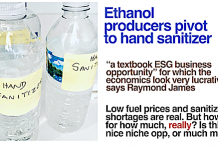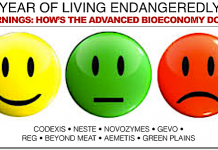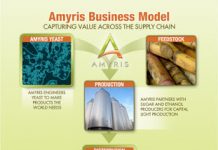Jim Lane
Like to quickly understand the surge in renewable chemicals and one of the hottest companies in the hottest sector of the bioconomy?
Here’s our 10-minute version of the IPO from Elevance Renewable Sciences. Complete with the risks, translated into English from the original SEC-speak.
In Illinois, Elevance Renewable Sciences filed its S-1 registration statement relating to a proposed $100 million initial public offering. The number of shares to be offered and the price range for the offering have not yet been determined. The company indicated that it has apply to list the stock on NASDAQ under the ERSI symbol.
The company is currently ranked #15 in the world in the 2011-12 “30 Hottest Companies in Renewable Chemicals and Materials” rankings. The rankings recognize innovation and achievement in fuels, and renewable chemicals or materials development, respectively, and are based on votes from a panel of invited international selectors, and votes from Digest subscribers.
With this filing, Elevance becomes the 11th company to file for an IPO in the industrial biotech boom, which began with a successful listing on the NASDAQ by Codexis in 2010. IPOs by Amyris (AMRS), Gevo (GEVO), Solazyme (SZYM), and KiOR (KIOR) have followed. In recent months, PetroAlgae (PALG.OB), Myriant, Ceres, Genomatica and Mascoma have also filed S-1 registrations for proposed IPOs.
Here’s the S-1 registration, in a conveniently downsized 10-minute Digest version – with some commentary along the way as to what is driving value in the Elevance model, some opportunities for the intrepid investor, and some risks which we have translated from the ancient and original SEC into modern English.
Elevance’s IPO: The 10-Minute Version
Based in Illinois, Elevance Renewable Sciences creates high value specialty chemicals from natural oils using a Nobel Prize winning technology. The company creates ingredients for use in personal care products, detergents, fuels and lubricants, among other applications.
Elevance’s proprietary patent-protected technologies transform renewable plant-based oils into specialty, high performance green chemical products without the environmental risks of traditional petrochemical solutions. Elevance’s innovative technology is based on the work of Nobel Laureate Dr. Robert H. Grubbs, who pioneered the olefin metathesis catalyst development at The California Institute of Technology.
Elevance was created on the premise that a high performance, renewable, capital light, partnership-based business model will provide a unique market position based on a significant and sustainable advantage in the specialty chemicals market. The company has achieved rapid growth as a result and continues to focus on establishing unique partnerships and collaborations.
Markets: Specialty Chemicals
According to Datamonitor, the size of the global specialty chemical industry was approximately $706 billion in 2010. They currently estimate the addressable specialty chemical markets represent $176 billion in annual commercial opportunity. Specific targets include surfactants, lubricants and additives and polymers.
Markets: Intermediate Chemicals
They estimate that the total size of the oleochemical market was $38 billion in 2010. They estimate that the total size of the intermediate olefin market was $7 billion in 2008. This intermediate olefin market, on which they focus olefin production, consists of higher value olefins, specifically linear alpha olefins or linear internal olefins with ten or more carbon atoms.
The Technology
Their proprietary catalyst and process technology enables them to produce both unique specialty chemicals from biomass-based oils, including soybean, palm and rapeseed (canola) oil, with desirable functional attributes previously unavailable in the marketplace, as well as key intermediate chemicals that are in limited supply. These natural oils are available in liquid form in industrial quantities from a variety of geographic regions. These characteristics allow for low-cost transportation and storage compared to other renewable feedstocks such as industrial sugars, biomass and waste. Their ability to adjust inputs in real time allows them to take advantage of changes in feedstock prices and product demand.
Their specialty chemicals provide functional attributes that customers desire but that have not been commercially available at competitive prices. Their intermediate chemicals are direct replacements for olefins and oleochemicals for which demand is growing and supply is constrained. Their ability to use a wide variety of natural oil feedstocks and to produce our intermediate chemicals in several regions can help our customers mitigate input cost volatility and reduce supply concerns.
The Strategy
Complete rapid deployment of multiple world-scale facilities. They expect to have three world-scale facilities by the end of 2014, with combined annual production capacity of approximately one million metric tonnes (2.2 billion pounds).
Develop new and existing market partnerships to accelerate growth and maximize profitability. To accelerate growth, they plan to continue cultivating strategic partnerships with: Cargill, one of the world’s largest agribusinesses; Clariant International, a leading global specialty chemicals company; Dow Corning, a global leader in silicone-based technology and innovation; Royal DSM, a global science-based company; Stepan, a leading producer of surfactants; and Wilmar. These partners provide Elevance with sales and marketing expertise, established distribution channels, technical know-how, product and application development expertise and manufacturing infrastructure.
Invest in research and development to enhance product performance characteristics. They intend to leverage the intellectual property portfolio to target solutions for customers demanding higher performance chemicals than those offered today. They plan to continue to develop new specialty chemicals with increased functional attributes, such as highly concentrated detergents and lubricants that enable better fuel economy.
Leverage feedstock flexibility to maximize margins. They continuously monitor the costs of various feedstock alternatives to take advantage of their imperfect price correlations to each other and to selling prices.
Green Discount, vs the Green Premium: Conversion Costs Compared to Alternative Routes to Comparative Products
| Kerosene to N-Paraffin for Linear Alkyl Benzene | Naphtha to Ethylene to Intermediate Olefins | Elevance Process to Intermediate Olefins | |
| $/met. tonne | $/met. tonne | $/met. tonne | |
| Utility | $53 | $164 | $24 |
| Direct labor | $49 | $74 | $15 |
| Fixed costs, excluding depreciation | $42 | $75 | $24 |
| Total conversion costs | $144 | $313 | $63 |
The Near-term Commercialization Plan
Tolling. Their products are currently manufactured at commercial scale using tolling facilities, enabling them to validate their target cost of production for the biorefineries.
First commercial facility. Elevance is building an integrated biorefinery in Gresik, Indonesia, as part of a 50/50 joint venture with Wilmar International Limited, the largest global processor and merchandiser of palm, palm kernel and coconut oils. They plan to begin commercial operations at this facility by the second quarter of 2012. The Indonesia facility, at a total construction cost of approximately $30 million, is fully funded and currently under construction. The Indonesia facility will have an annual production capacity of 185,000 metric tonnes (400 million pounds), with an option to expand the annual production capacity to 370,000 metric tonnes (810 million pounds).
Second commercial facility. Elevance is repurposing an existing facility in Natchez, Mississippi into a 280,000 metric tonne (610 million pound)integrated biorefinery. The plan is to be operating in the second half of 2013.
Third commercial facility. By the end of 2014, they expect to be operating an additional world-scale facility in South America.
Overall, they expect construction of the first two facilities to cost $165 to $360 per metric tonne ($0.07 to $0.16 per pound) of annual production capacity compared to $920 to $2,300 per metric tonne ($0.42 to $1.04 per pound) of annual production capacity for conventional facilities.
Elevance as it sees itself: 8 Competitive Strengths
Proprietary technology. The proprietary metathesis technology platform is based on Nobel Prize-winning innovations in metathesis catalysis. The platform enables them to produce high-value specialty chemicals and direct replacement intermediate chemicals that are cost-advantaged compared to those available from conventional production methods.
High performance products. The specialty chemicals have unique and desirable functional attributes previously unavailable in the marketplace. They are currently commercializing products such as fuel additives and personal care products that have enhanced performance features. In addition, they have demonstrated our ability to secure a premium price for certain high performance specialty chemicals.
Low capital requirements. The biorefinery design requires less capital per unit of production than conventional technologies because of the following characteristics: (1) fewer major process steps; (2) lower operating temperatures and pressures; (3) limited production of hazardous and toxic by-products; and (4) the ability to integrate the process into existing industrial sites.
Low operating costs. Conversion using their process achieves lower unit-level production costs than alternative routes to comparable products because of the following characteristics: (1) more direct process, resulting in fewer conversion steps; (2) highly efficient and selective catalyst; (3) feedstock flexibility; and (4) lower operating temperatures and pressures, resulting in greater energy efficiency.
Established partnerships with industry leaders. They have developed strategic partnerships which provide us with sales and marketing expertise, established distribution channels, technical know-how, product and application development expertise and manufacturing infrastructure.
Feedstock flexibility. The primary feedstocks include palm, soy and rapeseed oils, though our technology has the flexibility to use many other natural oils. Their ability to adjust our inputs in real time allows them to take advantage of changes in feedstock prices and product demand.
Large and well-established end markets. The technology enables them to target a wide variety of end markets. They currently estimate the addressable specialty chemical markets represent $176 billion in annual commercial opportunity.
Rapid deployment of commercial production. They can rapidly deploy the technology because of: (1) an ability to repurpose or integrate into existing industrial sites; (2) a low capital requirement per unit of capacity; (3) existing and available large markets for the products; and (4) a relatively short engineering, procurement and construction cycle.
The Risks, Translated from SEC-speak
In SEC speak: We are an early stage company with a limited operating history and have incurred substantial net losses since our inception, including net losses attributable to our common stockholders of $14.9 million, $23.7 million and $33.6 million for the years ended December 31, 2008, 2009 and 2010, respectively. As of June 30, 2011, we had an accumulated deficit of $188.8 million. For the foreseeable future, we expect to incur additional costs and expenses related to the continued development and expansion of our business…anticipate continuing to incur losses for a period of time, and may never achieve or sustain profitability.”
In English: “We blew through nearly $200 million building either a transformative business or a money pit, we’re not 100% sure which.”
In SEC speak: We have generated limited revenues from the sale of our products and we face significant challenges to developing our business.
In English: “Now that we think of it, not everyone in the world actually bought an Iridium sat-phone.”
In SEC speak: The specialty chemical markets in which we operate are subject to litigation regarding patents and other intellectual property rights. In addition, many companies in intellectual property-dependent industries, including the chemical industry, have employed intellectual property litigation as a means to gain an advantage over their competitors. Currently, Materia is defending against a lawsuit filed by Evonik Degussa, in which Evonik Degussa has alleged that Materia has infringed its U.S. patents relating to specific types of catalysts for olefin metathesis chemical reactions.
In English: “And now for the biotech fight song: Two, four, six, eight, litigate.”
In SEC speak: We may encounter significant delays, cost overruns, engineering problems, equipment supply constraints or other unexpected difficulties which could cause construction to cost more than we currently anticipate.
In English: “We may be just kidding about those low capital requirements.”
In SEC speak: We lack direct experience operating world-scale commercial biorefineries, and may encounter substantial difficulties operating such biorefineries or expanding our business. We have never operated a world-scale commercial biorefinery. We have only completed two commercial-scale toll production runs of specialty chemicals and intermediate chemicals utilizing our proprietary biorefinery technology using palm oil.
In English: “We hear that there’s a difference between running a lemonade stand
and Minute-Maid.”
In SEC speak: The price and availability of our feedstocks may be influenced by general economic, market and regulatory factors and may be cyclical or volatile. The supply of feedstocks may be interrupted by growing season disruptions, low crop yields, crop disease, droughts, floods, infestations, natural disasters, farming decisions or governmental policies and subsidies. In particular, weather conditions have historically caused volatility in certain portions of the agricultural industry by causing crop failures or reduced harvests.
In English: “Any Biblical type events like you might expect from, say, global warming, could sink us.”
Financing to date
November 2007, sold to Cargill, 50,000 shares of our common stock and 843,645 shares of our Series A preferred stock in exchange for Cargill’s contribution of the NatureWax business and Cargill’s agreement to terminate certain license and other contractual rights it held under certain agreements between it and Materia; to Materia, 50,000 shares of our common stock and 843,645 shares of our Series A preferred stock in exchange for Materia’s assignment of all right, title and interest to the contributed NatureWax assets; and to each of the TPG Funds, 2,530,934 shares of our Series B preferred stock in exchange for approximately $45.0 million.
October 2009, March 2010 and August 2010, Elevance received $10.0 million in exchange for the issuance to the TPG Funds of $10.0 million in convertible promissory notes and warrants to purchase shares of our Series B preferred stock for $8.89 per share, for a total of $30.0 million in financing.
December 2010, issued 5,649,718 shares of Series C preferred stock in exchange for approximately $70.0 million in cash and $30 million in the conversion of long-term debt. Naxos Capital Partners S.C.A. SICAR, a Luxembourg-based private equity group, led the round with additional new investors including Total Energy Ventures International, the venture capital arm of French oil and gas company Total, joining TPG Star and TPG Biotech in the financing.
June 2011, investors purchased 2,556,238 shares of our Series D preferred stock in exchange for $50.0 million in cash. Naxos Capital Partners led the round which consisted of previous investors in the Company. In June 2011, the Company entered into an asset purchase agreement with Delta Biofuels, Inc. to acquire a biodiesel production facility in Natchez, Mississippi.
The bottom line
One of the best aspects of the renewable chemicals business is that companies like Genomatica and Elevance come to the public markets talking about green discounts, rather than a green premium. “Everyday low prices” is the ultimate in winning business strategies for a lot of companies – and they have rightly conceived of themselves as a refiner and partnered up with companies that have world-class sales & marketing capabilities for this sector.
Note the absence of the following in the Elevance business model: subsidy, tariff, mandate, incentive, tax credit, emerging market, or policy stability.
And there’s abounding evidence of the desire for green products in these established markets, from customers, so long as they cost and perform the same.
So, the are two big traunches of risk in this offering.
One, Elevance has filed its IPO before scale-up, and absent a major customer order. Scale-up itself poses a level of risk – not every industrial biotech process has performed at scale exactly as well as planned.
Two, there’s the feedstock risk. By working with palm, rapeseed and soybean oil, the company will be able to manage the arbitrage between the values in these segments, but it is exposed to long-term food sector demand for these oils, which may put the income statement substantially underwater should food oils become substantially de-linked from fossil crude oil, and result in unacceptably high prices for customers. Not to mention the potential for a continued de-linkage between natural gas and crude oil – and the chance that major discoveries in, say natural gas feedstocks, may put pressure on the pricing and margins.
Big concerns? Well, for the smaller investor, all concerns are big concerns because it’s tougher to hedge them out. Fair to say that the big risks are relatively remote failure possibilities, that most renewables business have these sort of risks, and over time they diminish as peak oil, or peak natural gas, put more pressure on the petrochemical industry than the renewables industry.
The complete S-1 registration statement is here.
Jim Lane is the Editor and Publisher of Biofuels Digest.








